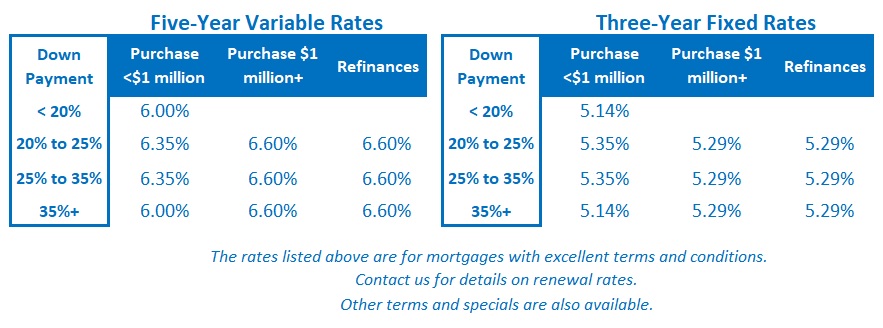Why Canadian Fixed and Variable Mortgage Rates May Be Heading in Different Directions
February 26, 2024The Longer the First Rate Cut Takes, the Lower Our Variable Mortgage Rates Will Go
March 11, 2024
It will be a shock if the Bank of Canada (BoC) moves its policy rate when it meets this week.
The first reason is procedural.
The Bank meets eight times each year. At four of those meetings, its policy statement is accompanied by both a lengthy press conference and the release of its latest Monetary Policy Report (which provides an in-depth assessment of economic conditions at home and abroad).
If the BoC is going to enter a new phase of its policy-rate cycle, it will almost certainly be at a meeting where it can provide its detailed rationale for doing so. (For reference, the Bank’s next two such meetings will be on April 10 and July 24.)
This week’s meeting will be one of the other four, where the BoC issues its policy statement on its own and then everyone leaves quietly through the back door as if they have a bus to catch.
Procedure aside, the BoC will also likely want more time to assess the evolving incoming data.
On that note, our headline Consumer Price Index (CPI) dropped from 3.4% in December to 2.9% in January on a year-over-year basis, and core CPI, which strips out volatile food and energy costs, fell from 3.7% to 3.4% over the same period. With mortgage interest costs excluded, as they are in many other countries, our CPI came in right at the Bank’s 2% target last month (hat tip to Ben Rabidoux for that observation).
Although the BoC will be encouraged by our latest CPI data, I think it will remain cautious for the time being because it has consistently hinted that it prefers to err on the side of overtightening.
The Bank will also want to see how that continued disinflation is impacting business and consumer expectations. (Our next Consumer Expectations and Business Outlook surveys are due on April 14.)
There is good reason to believe that inflation will continue to slow in the months ahead.
Last week, Statistics Canada confirmed that our GDP increased by 1% in Q4, 2023. It also revised its previous estimate for Q3 higher, from -1.0% to -0.5%.
While the Q4 GDP result was higher than the consensus call of 0.8% and well above the BoC’s most recent flat forecast for that period, it confirmed that our economy is still hovering at stall speed.
The composition of our current GDP growth also portends more disinflation ahead.
Stats Can’s latest data confirmed that exports led our GDP higher in Q4 while domestic demand contracted. Falling domestic demand should help reduce the cost services, which account for most of our remaining inflation pressure.
Disclaimer worth repeating: Our headline GDP continues to be buoyed by soaring immigration levels, but our GDP-per-capita, which is the economic reality that individual Canadians experience, has declined in five of the last six quarters. (That explains why many people feel as though we’re in a recession even their experience isn’t directly reflected in our headline data.)
The biggest reason to expect a further reduction in demand (and inflation) in the months ahead is the ongoing wave of mortgage-rate resets.
Only about half of Canadian mortgage borrowers have had to renew into higher rates thus far, and overall debt payments are already absorbing a record amount of our discretionary income.
The magnitude of the rate resets still to come will intensify further as an increasing number of borrowers, who are paying ultra-low pandemic rates, come up for renewal. Unless rates fall very quickly from here, discretionary spending will be crimped even more than it is now. (Credit-card and car-loan delinquency rates have spiked higher, and so have business bankruptcies.)
The coming rate resets will ensure that financial conditions will continue to tighten well into the future, regardless of what the BoC does this Wednesday, or throughout the remainder of 2023.
If it hasn’t been obvious up to this point, I’m still not buying the soft-landing narrative.
To be clear, I’m not saying we should all start hoarding canned goods and buying rifles to guard our vegetable patches. The sky isn’t likely to fall anytime soon. But it does seem likely that the BoC won’t wait much longer to start cutting its policy rate if it’s going to skate where the puck is going.
Put me down for no change by the Bank at its meeting this week but for a more dovish tone in its policy statement.  The Bottom Line: Government of Canada bond yields finished the week a little lower. But gross lending spreads are still relatively tight, so bond yields will likely need to decline further before we see any further change in fixed rates.
The Bottom Line: Government of Canada bond yields finished the week a little lower. But gross lending spreads are still relatively tight, so bond yields will likely need to decline further before we see any further change in fixed rates.
Variable-rate discounts have started to widen out a little.
In summary, I don’t expect the BoC to cut its policy rate when it meets this Wednesday. I do expect the Bank to adopt a more dovish tone, with an outside chance that it will signal that its first rate cut may not be too far off.







